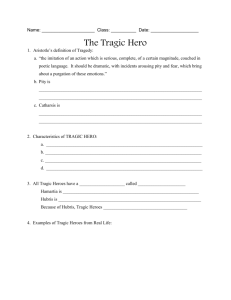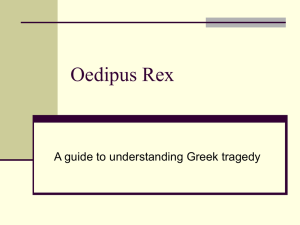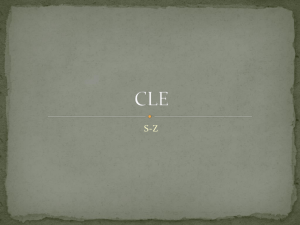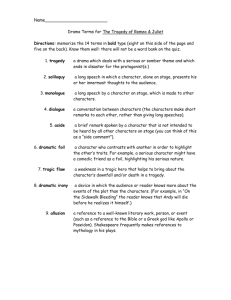Athenian Tragedy: Origins, Context, Practice (Csapo reading)
advertisement
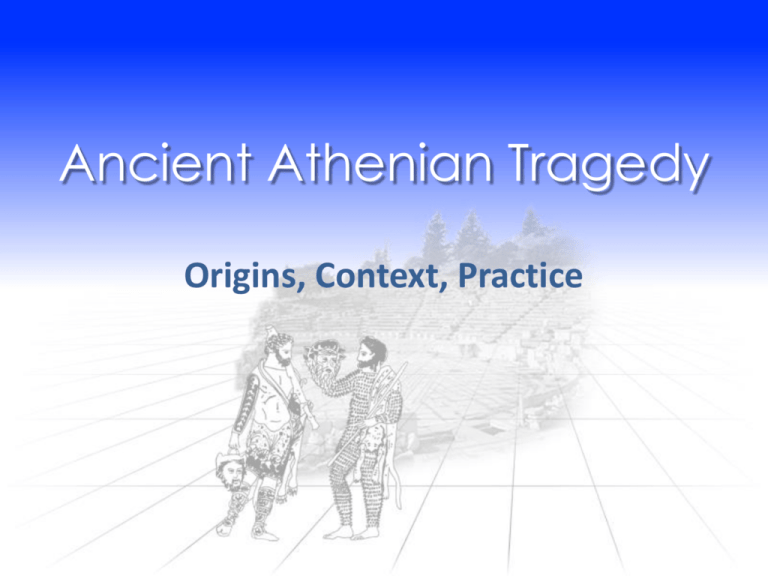
Ancient Athenian Tragedy Origins, Context, Practice Tragedy: Ritualized Secularism • Dual Focus (Barlow) • Mythic, archetypal • Contemporary, topical • Ambivalent affirmation Theater at Epidaurus 13-Sep-11 Csapo 2 Agenda • Opening discussion • The Fasti • Tragic Origins • Athenian Tragedy • Athenian Theater, Tragic Drama • Your Comments • Background, Evidence, Illustration • Cult, komos, Phallic Procession • Occasion and Context • Where, What, How 13-Sep-11 Csapo 3 Opening discussion Your Comments Issues… • Confused! • Athenian drama through a • • • • modern lens Plays as critique? • Artistic liberties? Citizen role? Political/social aspects? • Emergence of urban culture Religious aspects? • Why gods (esp. Dionysus)? • Cultic elements • Competitive aspects • Choosing of khorēgoi • How people heard the • • • actors 3-actor rule? Theater • Lighting? • Rebuilding? • Paucity of remains? Festival: changes? • (Proto)satyrs? • Plays that illustrate? 13-Sep-11 Csapo 5 The Fasti Background, Evidence, Illustration BBC Map of Ancient Greece Chronology: Athenian Drama • 561-527 BCE Peisistratus’ tyranny • • City/Greater Dionysia Tragic competition, 535/4 or 508 or 501 (?) • 535-531? Thespis and tragedy • • • • • • Actor-“answerer” (hupokrites) ca. 520-510 Satyr plays introduced 486 First known comic competition 508/7 Democracy 453 Athenian empire 449 actor’s prize, Greater Dionysia 13-Sep-11 Csapo Tragic mask 9 Chronology: Athenian Tragedians • 525-455 BCE Aeschylus • 1st victory 484 • 2nd actor added • ca. 496-ca. 406 Sophocles • 1st victory 468 • 3rd actor added • 484?-406 BCE Euripides • 1st victory 441 • Solo arias (“monodies”) 13-Sep-11 Csapo Tragic mask 10 Choregic commemorative inscription honoring khorēgoi Auteas and Philoxenides, 313–312 BC Fasti (inscribed drama record, Athens) 1. Name of that year’s presiding archon 2. 3. 4. 5. (“archon eponymous”). Name of victorious tribe, boys’ dithyramb. Name of victorious tribe, men’s dithyramb. Name of victorious khoregos and didaskalos (“director”) in comedy. Victorious khoregos and didaskalos, tragedy. • 449/447 (?) BCE, victorious actor in tragedy. komos (plural komoi) Tragic Origins Cult, komos, Phallic Procession Dionysus with Satyrs, Athenian cup (“Brygos painter”) circa 510 BCE Proto-Dramatic Performance Kōmos, Satyrs Phallic procession Komasts: archaic Corinthian vase Satyrs, Maenads, Dionysus. Athenian, early 500s BCE 13-Sep-11 Csapo Procession of the Phallus Pole 15 Return of Hephaistos Dionysus Hephaestus padded, phallic costume Proto-Drama (?): komos-like Performance of the Return of Hephaestus Protocorinthian vase painting , 600-575 BCE Dionysian Masks Red-Figure Athenian Vase, 500s BCE Red-Figure Athenian Vase, 500s BCE Tragic chorus: masked, dancing, singing (ancient vase) Athenian Tragedy Occasion and Context Athenian Dramatic Festivals • Rural Dionysia (Dec.) • Lenaea (late Jan/Feb, from 440/430-) • citizens • Anthisteria (Feb) • City/Greater Dionysia (late March) Dionysus • anyone • (theoric fund) 13-Sep-11 Csapo 20 Greater Dionysia: Program Dramatic preliminaries “Showtime” • • Prefest • • • • • • Men’s choruses of 50 • Boys’ choruses of 50 chorus assignments Proagōn “Introduction” Pompē Ceremonies 13-Sep-11 Dithyramb — 10 • • Csapo Comedies — 5 Tragedy — 3 tetralogies 21 Tragic Tetralogy Four plays, one playwright Aeschylus’ Oresteia (458 BCE) 1. 2. 3. 4. 1. 2. 3. 4. Tragedy Tragedy Tragedy Satyr drama Agamemnon Libation Bearers Eumenides Proteus Citizen judging 13-Sep-11 Csapo 22 Athenian Theater, Tragic Drama Where, What, How Athenian Acropolis N Parthenon Odeon Roman Theater of Herodes Atticus Theater of Dionysus Temple of Dionysus Eleutherius Theater of Dionysus ca. 420 BCE theatron (“viewing place,” auditorium, theater) wooden bleachers stone seats (dignitaries) orkhēstra (“dancing space” for chorus) kerkis (“wedge” seating section) altar entry (parodos) entry (parodos) Low wooden stage with, steps, skene (from ca. 420 BCE) skene (stage building) Theater of Dionysus, Athens (from East) 13-Sep-11 Csapo 27 Production: Personnel & Gear Personnel • poet • poiētēs, “maker” • producer • khorēgos • director • didaskalos, “teacher” • actors • hupokritai • chorus, “chorus leader” • khoros, koruphaios • piper • aulētēs 13-Sep-11 Gear, etc. • Masks • Costumes • Music • Props • Scenery • Special effects • mekhanē • ekkuklēma Csapo 28

